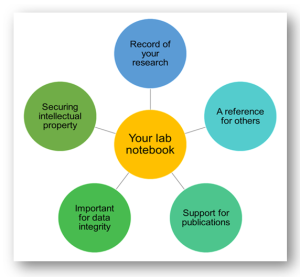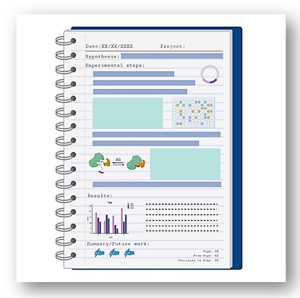The Lab Notebook: A Researcher’s Best Friend
It has often been said that the difference between “science” and “messing around” is that in science, you have to write stuff down. Keeping a good written record of your research is a key skill to learn as you progress as a scientist, no matter if you’re working in academia, industry, or in the public sector. Very often, the written record is in the form of a “lab notebook”.
As a researcher, a lab notebook is one of your most valuable resources and best friends. Your notebook is the primary record of your research, which you (and others) can refer to for information on your work. Your notes can be used as support for publications and presentations, as a reference for your lab mates for protocols and methodology, and as proof of your intellectual property. This can support any patents that you and your team can apply for.
First things first: what makes a good lab notebook?
The purpose of your notebook is to provide an account of your work. Bearing that in mind, what qualities make your lab notebook a good one? It must be accurate, truthful, and complete. Your record must also be easy to read, understand and follow, by colleagues or even your future self. If you can’t make sense of what you’ve written, your lab notebook will be of very little help to you later on.
Below, we lay out some guidelines for helping you maximize the effectiveness of your record, so you can get the most out of this valuable resource.
Tip one: take advantage of different notebook formats.
First, you need to choose the type of lab notebook you’ll be using. This can be different based on the nature of your work. Your lab notebook can be a physical paper notebook or an electronic one. Both options have pros and cons:
Since both methods are useful in their own ways, it can be beneficial to take advantage of this and use both in parallel. The paper notebook is best for daily use; all the details of experiments, procedures, and mistakes can be recorded quickly in real-time. In a broader view, the lab notebook is not only the book you are using for recording, but it also goes beyond and refers to any files related to your daily work in the lab. Optimized procedures and protocols, as well as results and conclusions, can then be written in the electronic lab notebook which can be easily backed up and shared with others. As the information is stored separately in e-book and handbook, the e-version notebook can be cross-referenced to handwritten notebook by date, project titles, figure IDs etc.
Tip two: structure your lab notebook in an orderly way.
The exact way you structure your lab notebook can vary depending on what works for you; there is no one way to keep a lab notebook. Below are some guidelines for good practice to follow for formatting your notebook:
- Include your name, email, and lab on the first page so the notebook can be returned to you if it goes missing.
- Leave several pages at the start of the notebook blank so you can include and update a table of contents.
- Number each page of your notebook, and use these numbers in your table of contents.
- Start each new topic (notes, results, experiments etc.) with a title and a date on the top of the page.
- All “loose” pages should be taped securely into your notebook.
- Do not tear out pages from the lab notebook, even “rough work”, or a mistake.
- Do not erase anything from your notebook; use pens not pencils when writing.
Tip three: include lots of detail in your lab notebook entries.
Consider carefully about what exactly you’ll be including in your lab notebook: which details to include, and how much information is needed. When it comes to keeping a record of your research, “less is more” doesn’t apply: more is more. You will never regret including more details in your notebook, and being thorough in your documentation will make your life easier when it comes to referring back to your research (for publications and presentations).
Below is an example of a page from a lab notebook, which includes the necessary components to ensure you’re keeping a good written record of your work:
- The date of the entry
- A title for the entry
- Page number
- Your hypothesis for the experiment (optional depending on the work you’re doing)
- The experimental steps carried out
- Names and catalogue numbers of kits and reagents used
- Results of your experiments
- Pictures of your results (e.g., graphs) taped securely to the pages
Tip four: update your notebook as you go.
The biggest lie we tell ourselves is “I’ll remember that later”. It’s important to keep your lab notebook up to date. In order to include the most accurate account of your research, updating your notebook as soon as you can is best. Don’t wait too long after you’ve conducted your experiments to document them, you will likely forget an important detail if you’re only writing it down a week later!
Tip five: back up your work (and back it up again).
Unexpected things always happen, laptops crash; things go missing; reagents (or your lunch) can spill on the most valuable data. Backing up your notebook allows you to access your record at any time. Some people will say that if data doesn’t exist in at least three places, then it doesn’t exist! Backing up electronic records is very easy: an external hard drive or an online drive will be good helpers. Even with a handwritten notebook, it is still recommended to make an electronic backup, which can be done by scanning or photographing the pages of your notebook regularly and saving these electronically.
Conclusion
Taking notes in your lab notebook can often seem like a chore, or less important than the experiments you are conducting. Keeping a good record can often be a difficult skill to learn, but taking the time to develop good documentation skills is highly worthwhile, no matter where your career takes you. Well-organized lab notebooks help you to have a record of your research progress, which always allows you to pick up where you left off. Everything recorded, especially brilliant ideas crossing your mind, in the notebook guide you to step into further important movements. Therefore, your lab notebook is not only about what you have done, it can be a bible for your future work and research plans. Have a long-term habit to keep organized and a good record will assist you in multiple ways to get success in research. The best way to learn how to keep a good record is through your own work, so now you know the basics, get started yourself!
______________________________________________
About the Authors:
Diwen Wang is a PhD candidate in the Department of Botany and Plant Pathology at Purdue University, and a 2023 Plantae Fellow. She is now focusing on the interaction between plant and plant pathogen. You can find her on Twitter at @Diwen_w.
Grace Pender is a plant genetics PhD student in University College Dublin, studying plant architecture in hemp, and a 2023 Plantae Fellow. She enjoys crochet, watching ballets and musicals, and is very passionate about equality, diversity and inclusion in science. You can find her on Twitter at @Grace_Pender_31.







